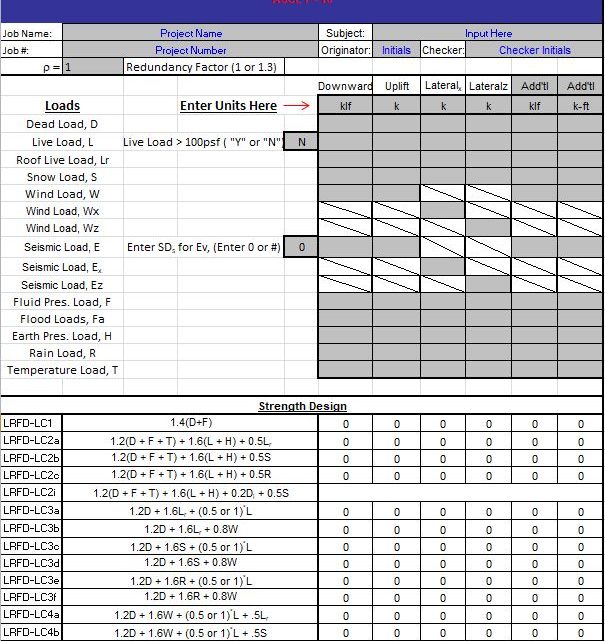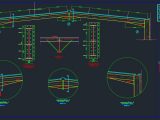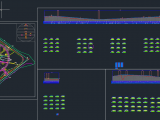
ASCE 7-10 Load Combinations Spreadsheet
5 May 2025Table of Contents
ASCE 7-10 Load Combinations Spreadsheet
In the world of structural engineering, safety and reliability are everything. That’s why design codes like ASCE 7-10 exist—to set the standard for how buildings and other structures should be designed to withstand various loads. One of the most important concepts in this code is load combinations. If you’re a civil or structural engineer, architect, or student diving into structural analysis, understanding these combinations is crucial for ensuring code compliance and structural safety.
What is ASCE 7-10?
ASCE 7-10 is a standard published by the American Society of Civil Engineers titled Minimum Design Loads for Buildings and Other Structures. It defines the types and magnitudes of loads—such as dead, live, wind, snow, and seismic—that structures must be designed to resist. It also provides the load combinations engineers must consider when calculating internal forces, member sizes, and structural stability.
What Are Load Combinations?
Load combinations are sets of different loads applied to a structure simultaneously. Since it’s unlikely that maximum values of all loads (e.g., live load, wind load, and seismic load) will occur at the same time, ASCE 7-10 provides a set of rational combinations that reflect realistic and safe scenarios.
Why Do Load Combinations Matter?
Without proper load combinations, a structure might be underdesigned for one scenario or overdesigned for another. Either way, that leads to safety risks or unnecessary construction costs. By following ASCE 7-10’s prescribed combinations, engineers ensure a balance between safety, efficiency, and code compliance.
ASCE 7-10 Load Combinations Explained
ASCE 7-10 divides load combinations into two main categories:
1. Strength Design (or Load and Resistance Factor Design – LRFD)
This method applies load factors to account for uncertainties in loads. The idea is to apply higher loads and compare them to a reduced resistance. Here are some common LRFD combinations (paraphrased for clarity):
-
1.4D
-
1.2D + 1.6L + 0.5(Lr or R or S)
-
1.2D + 1.6(Lr or R) + (L or 0.5W)
-
1.2D + 1.0W + L + 0.5(Lr or R)
-
1.2D + 1.0E + L + 0.2S
-
0.9D + 1.0W or 0.9D + 1.0E (for stability under uplift or overturning)
2. Allowable Stress Design (ASD)
ASD uses lower load factors (or none) but compares these loads against full member strength. Here are typical ASD combinations:
-
D
-
D + L
-
D + (Lr or S or R)
-
D + L + (Lr or S or R)
-
D + W
-
D + E
-
0.6D + W or 0.6D + E
Key Terms in Load Combinations
Let’s break down what each letter represents in the combinations:
-
D – Dead Load (permanent structural and non-structural weight)
-
L – Live Load (occupant or furniture loads)
-
Lr – Roof Live Load
-
S – Snow Load
-
R – Rain Load
-
W – Wind Load
-
E – Earthquake (Seismic) Load
Tips for Applying ASCE 7-10 Load Combinations
-
Use the Right Design Method: Make sure you’re applying the correct combinations for LRFD or ASD depending on your design philosophy.
-
Follow Local Code Amendments: Some jurisdictions modify ASCE 7-10 slightly, so always double-check.
-
Use Structural Software: Programs like ETABS, SAP2000, or STAAD.Pro allow you to input custom or code-based combinations easily.
-
Consult with a Senior Engineer: Load combinations might seem simple, but improper application can lead to critical errors.
Mastering ASCE 7-10 Load Combinations is fundamental for every structural engineer. These combinations are more than just numbers—they represent years of research, case studies, and best practices designed to protect lives and property. Whether you’re designing a small residential building or a complex high-rise, understanding and applying these load scenarios correctly is non-negotiable.
By staying up-to-date with ASCE 7 standards and using sound engineering judgment, you’ll ensure that your structures not only meet code but stand strong for decades to come.


